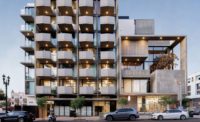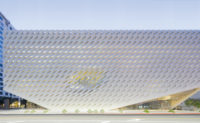San Diego, California
When architect-developer Jonathan Segal named one of his recent buildings “The Q,” he says he was looking for “the cool factor, the debonair suaveness” of James Bond. Q is, famously, Agent 007’s gadget inventor, creator of dagger-edged shoes and mini–rocket launchers that masquerade as cigarettes. For this building in San Diego’s Little Italy, Segal aspired to Bond’s sleek sophistication, rather than a tricked-out design. But he did not anticipate the need to perform his own Q-like feat of swift transformation as the program changed, midconstruction, from offices to housing.
Since launching his firm in 1989, Segal has mainly focused on market-rate residential work. Performing simultaneously as designer, client, and builder, he has completed 17 multifamily projects in San Diego, taking on challenging lots and derelict structures in undervalued neighborhoods on the upswing. This time, he says, “I got the idea to do an office building instead. They seemed to get better rents and cost less to construct.” And Little Italy is an increasingly desirable downtown district lacking offices. Set along a scenic harbor, it was once a commercial fishing neighborhood that declined with the local tuna industry and the construction in the 1960s of a freeway plowing through it. More recently, galleries, boutiques, and mixed-use residential projects have gentrified the area.
Segal envisioned the 90,000 square-foot Q as a “podium” for his family’s return to a neighborhood they loved (and had reluctantly left three years earlier): The offices and street-level commercial space would literally and financially underlie their 5,800-square-foot duplex penthouse.
No sooner was the structure capped than the economy tanked and “the office market evaporated,” says Segal. With a nimbleness only possible for an architect-client, he quickly repermitted the building for mixed-use residential.
Since the overall form and fundamental elements had been in place before the program change, the project became akin to adaptive reuse. Befitting the neighborhood’s modest scale, Segal’s massing suggests a small cluster of buildings, rather than a single 200-by-50-foot megablock. Further lightening the visual impact, he made the building volumes clean-lined and transparent, with wraparound, floor-to-ceiling glass, punctuated by a brise-soleil of projecting concrete floor slabs. While the concrete structure required 700 new holes to accommodate apartment plumbing, the dramatic office glazing was a plus, offering the 29 residential units layout flexibility and unusual sleekness. To meet code, the number of apartments—all rentals, ranging from 400 to 1,800 square feet—corresponds precisely to the existing underground parking spaces. In the spirit of lofts, many of the tenants both live and work there.
Above a street-level restaurant and café, the taut, quasi–International Style skin becomes more solid, framed by a black-painted aluminum shell. At one corner of the building, Segal integrated Little Italy’s oldest home, the 1888 A.W. Pray House, a Gothic Victorian, which he relocated from the lot’s western to its eastern side. Newly restored, it’s now a clothing boutique.
The Q has plenty of green features, though Segal denies being a “tree hugger” or even a proponent of LEED certification. Rooftop solar panels power the common areas, and deep overhangs shade low-E glazing. Operable windows bring air and light through the “gill slits,” or angled fins, along the north facade.
Though the rents, ranging from $950 for a studio to $5,200 for a two-bedroom duplex, exceed the neighborhood average, Segal says he leased everything instantly. So why has the Q succeeded when nearby residential lofts lie partially vacant? “We offered something different,” he suggests, “not boxes punched with holes, not transplanted suburban homes, but places that capitalize on the city experience.” Indeed, as you look out over the harbor or at the larger-than-life downtown skyline, it all seems stunningly urbane—you half expect your shoe phone to ring.
Sarah Amelar is a contributing editor to Architectural Record.
Location:
750 West Fir Street
San Diego, CA 92101
Gross Square Footage: 90,000 sq.ft.
Construction cost: $11 million
Completion date: June 2011
People
Owner:
Architect:
Personnel in architect's firm who should receive special credit: Architect of record: Jonathan Segal FAIA
Interior designer:
Engineer(s):
Consultant(s): Exhaust Ventilation Specialist: Andy Duncan HVAC: Rob Zarick General contractor: Jonathan Segal FAIA
Photographer(s): Renderer(s): Arturo Maldonado CAD system, project management, or other software used: Archicad |
Products
Structural system
Exterior cladding Metal Panels: Ideal Mechanical
Metal/glass curtain wall:
Moisture barrier:
Roofing Tile/shingles: Owens Corning (historic house)
Windows
Fleetwood windows and doors
Doors Metal doors: US aluminum
Sliding doors:
Hardware Security devices: Siedle
Interior finishes Paints and stains: Frazee Floor and wall tile: Cali Bamboo Carpet: Flor Tiles
Lighting
Dimming System or other lighting controls:
Conveyance
Energy
Photovoltaic system: Other unique products that contribute to sustainability: Low Flow toilets/showers
Add any additional building components or special equipment that made a significant contribution to this project: |











Post a comment to this article
Report Abusive Comment